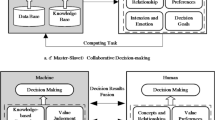Abstract
NΣ-labeled calculus is a generalization of N-labeled calculus so as to describe time-concerned recognition, knowledge, belief and decision of humans or computer programs together with related external physical or logical phenomena. N-labeled calculus is the smallest formal system applicable to verification and analysis of cooperative real-timing systems on natural number time introduced as an adaptation of tense arithmetic (TA). A merging problem of vehicles with misunderstanding or incorrect recognition is discussed as an example of cooperating systems controlling continuously changing objects including human factor. Euler’s approximation is introduced in order to represent the continuously changing objects. Through this example, relationship among artificial intelligence, external environment and human factors is investigated.
Similar content being viewed by others
References
Mizutani T, Igarashi S, Ikeda Y, et al. Labeled @-calculus: formalism for time-concerned human factors. In: Proceedings of AISC 2006. LNAI, 2006, 4120: 25–39
Igarashi S, Mizutani T, Ikeda Y, et al. Tense arithmetic II: @-calculus as an adaptation for formal number theory. Tensor, N. S., 2003, 64: 12–33
Igarashi S, Shirogane T, Shio M, et al. Tense arithmetic I: formalization of properties of programs in rational arithmetics. Tensor, N. S., 1998, 59: 132–152
Igarashi S, Shio M, Mizutani T, et al. Specification and verification of cooperative realtiming processes in @-calculus. to appear
Hiraga R, Igarashi S. Psyche: computer music project, University of Tsukuba. In: Proceedings of International Computer Music Conference. 1997, 297–300
Igarashi, S. Science of Music Expression. Tokyo: YAMAHA Music Media, 2000 (in Japanese)
Igarashi S, Mizutani T, Shirogane T, et al: Formal analysis for continuous systems controlled by programs. LNCS, 1996, 1179: 347–348
Mizutani T, Igarashi S, Shio M. Representation of a discretely controlled continuous system in tense arithmetic. Electr. Notes in Theor. Comp. Sci., 2001, 42. http://www.elsevier. com/locate/entcs/volume42.html
Fagin R, Halpern J Y, Moses Y, et al. Reasoning About Knowledge. The MIT Press, 1995
Chaochen Z. Duration calculus, a logical approach to real-time systems. In: Proceedings of AMAST’ 98. LNCS, 1998, 1548: 1–7
Damm W, Hungar H, Olderog E R. Verification of cooperating traffic agents. International Journal of Control, 2006, 79: 395–421
Shoenfield J R. Mathematical Logic. Massachusetts: Addison-Wesley Publishing Company, 1967
Igarashi S, Mizutani T, Ikeda Y, et al. Labeled calculi, logical spaces and cosmos. In: Proceedings of AWFS 2007. 2007, 39–41
McCarthy J, Sato M, Hayashi T, et al. On the Model Theory of Knowledge. Stanford University Technical Report, STNCS-78-657, 1979
Author information
Authors and Affiliations
Corresponding author
Rights and permissions
About this article
Cite this article
Mizutani, T., Igarashi, S., Shio, M. et al. Human factors in continuous time-concerned cooperative systems represented by NΣ-labeled calculus. Front. Comput. Sci. China 2, 22–28 (2008). https://doi.org/10.1007/s11704-008-0010-2
Received:
Accepted:
Published:
Issue Date:
DOI: https://doi.org/10.1007/s11704-008-0010-2




